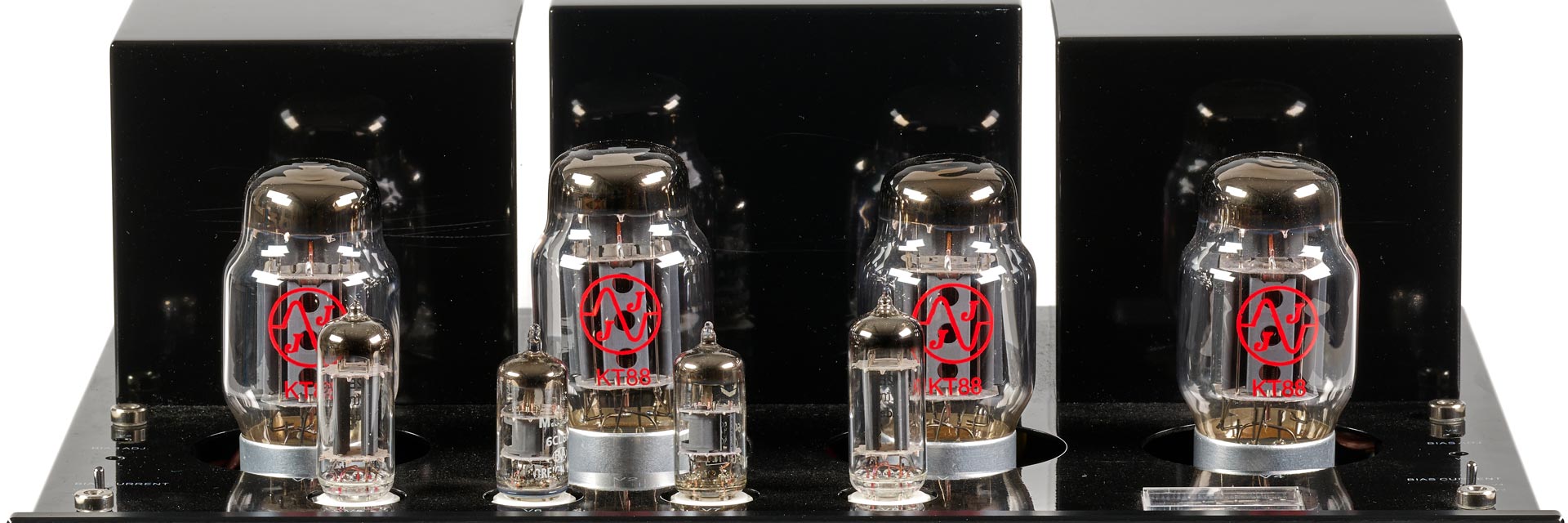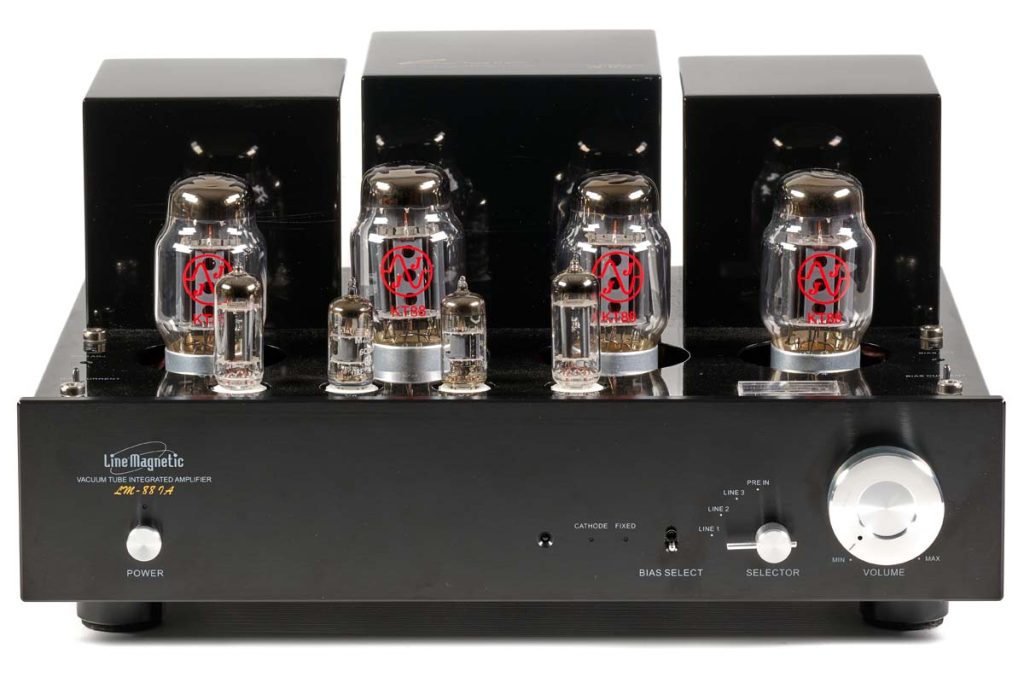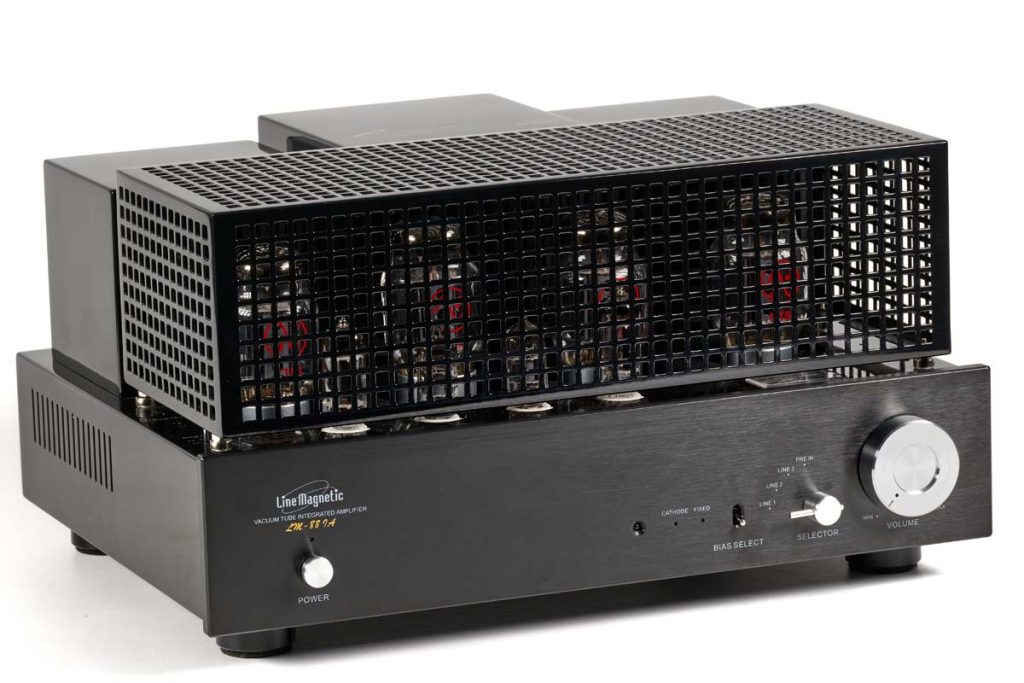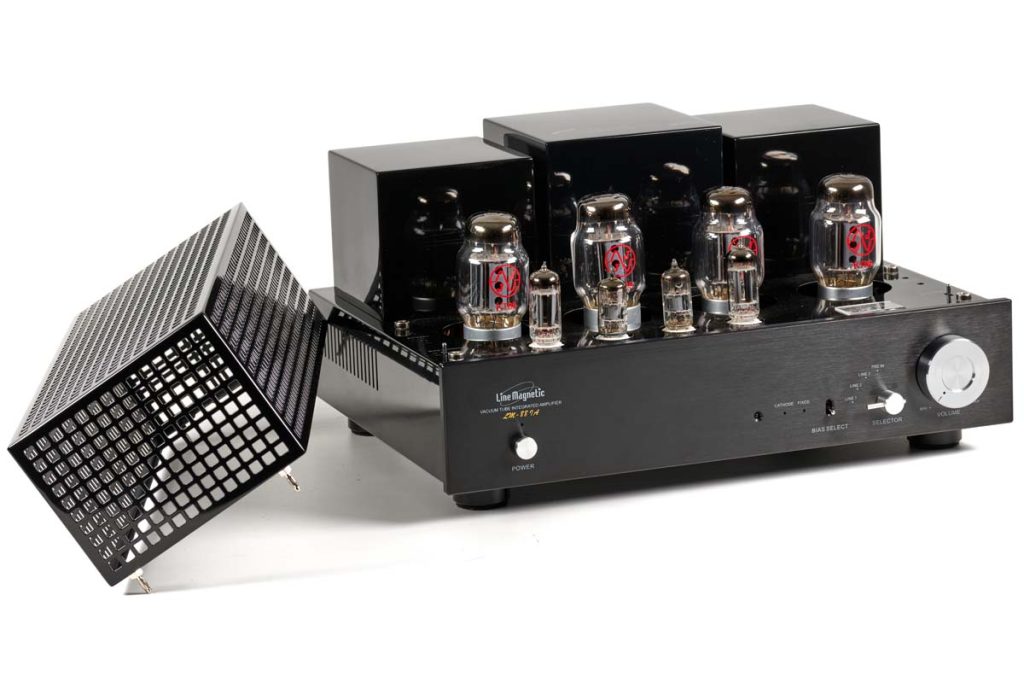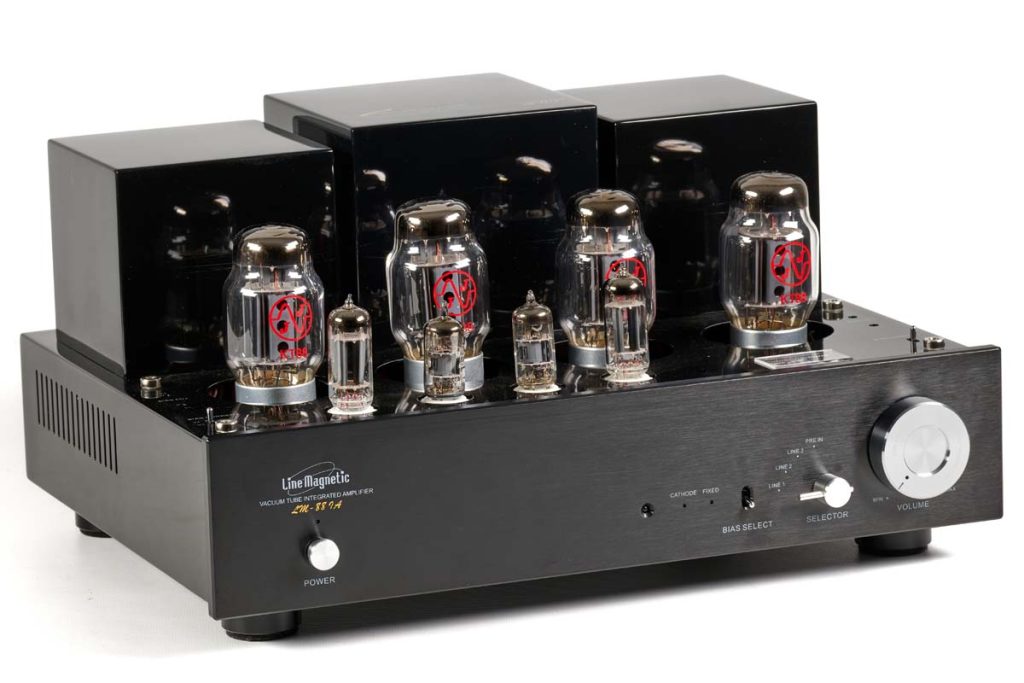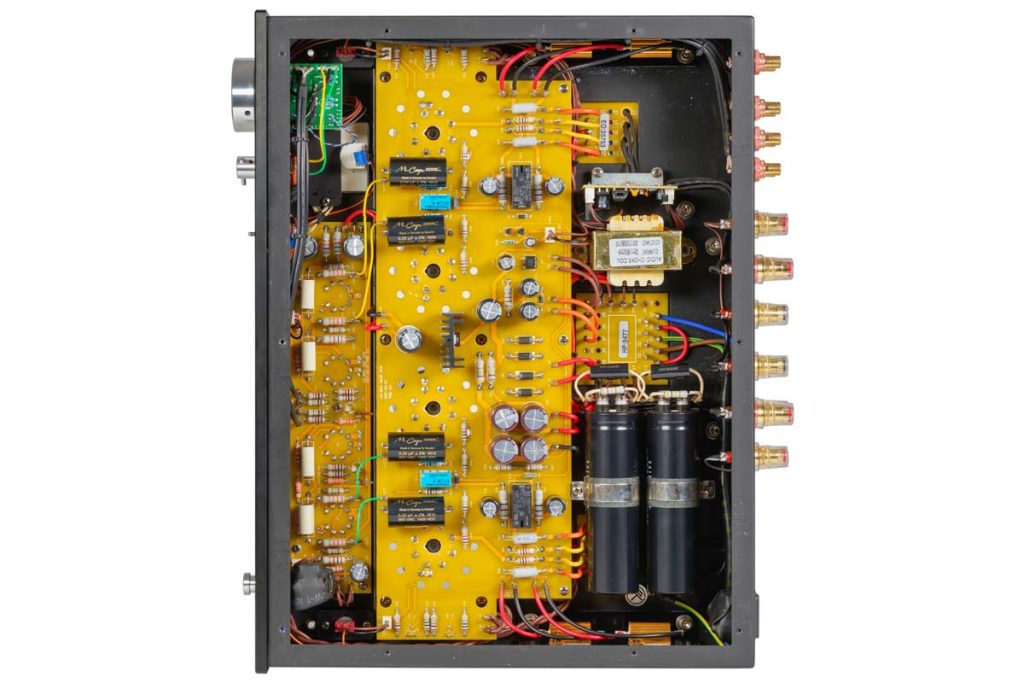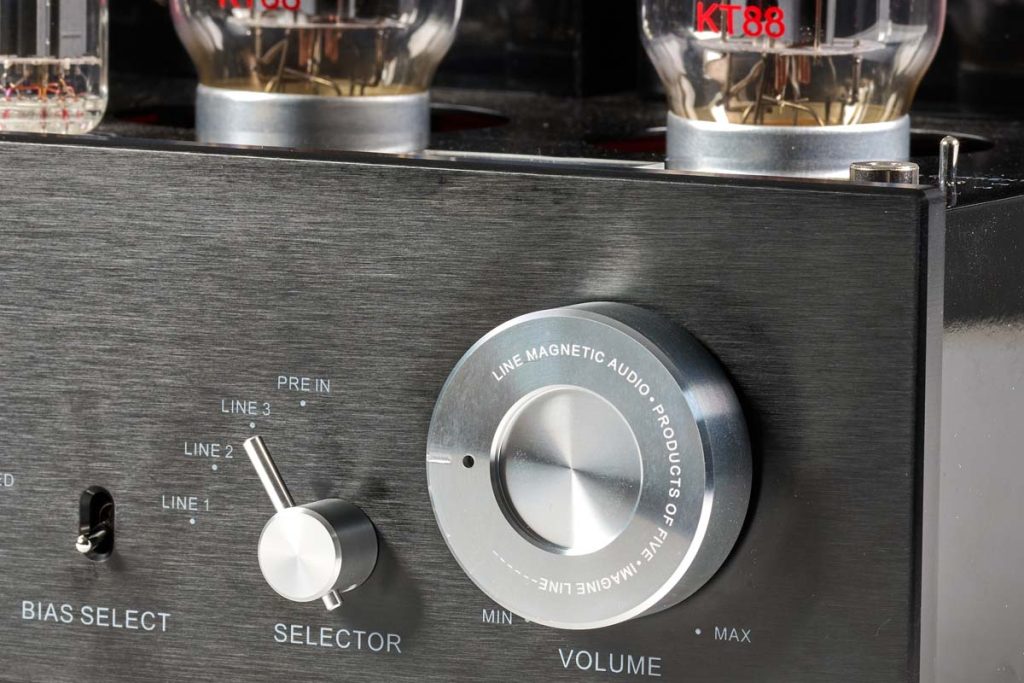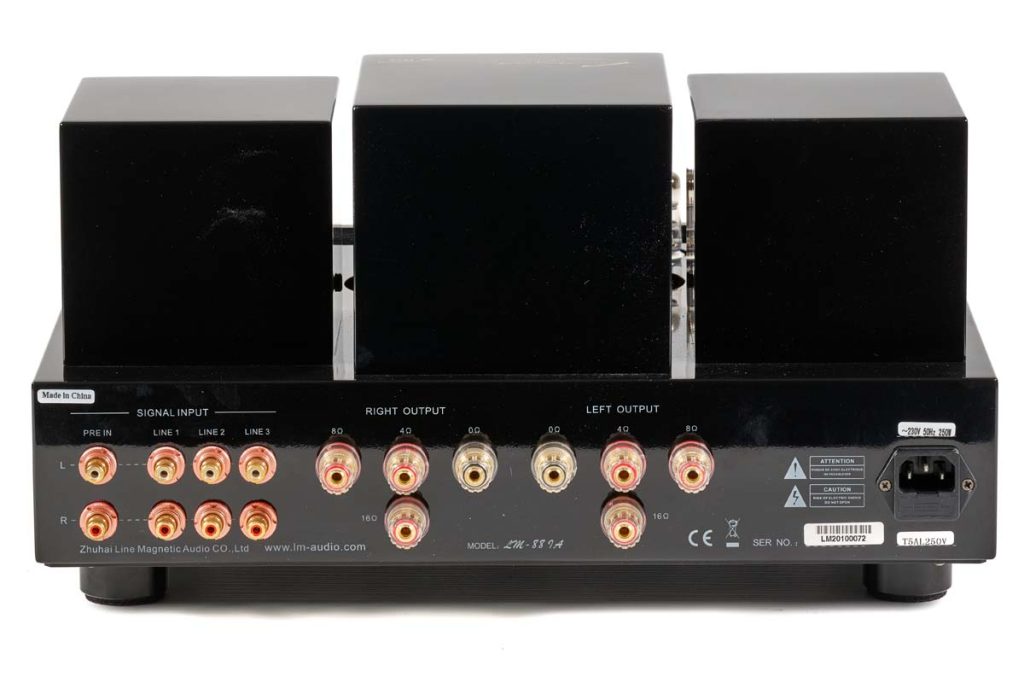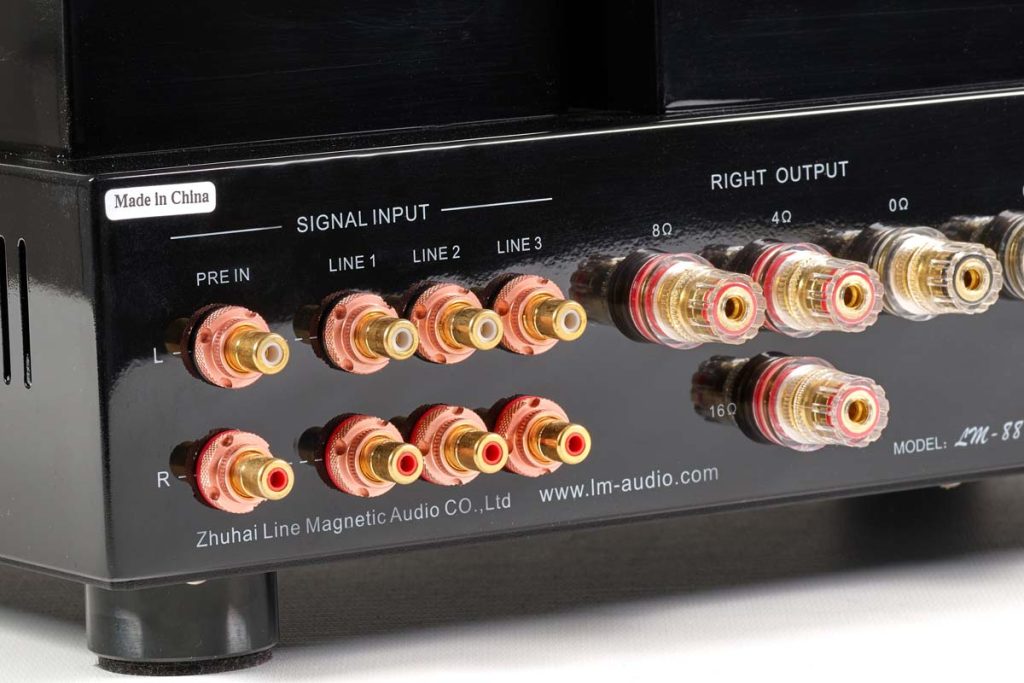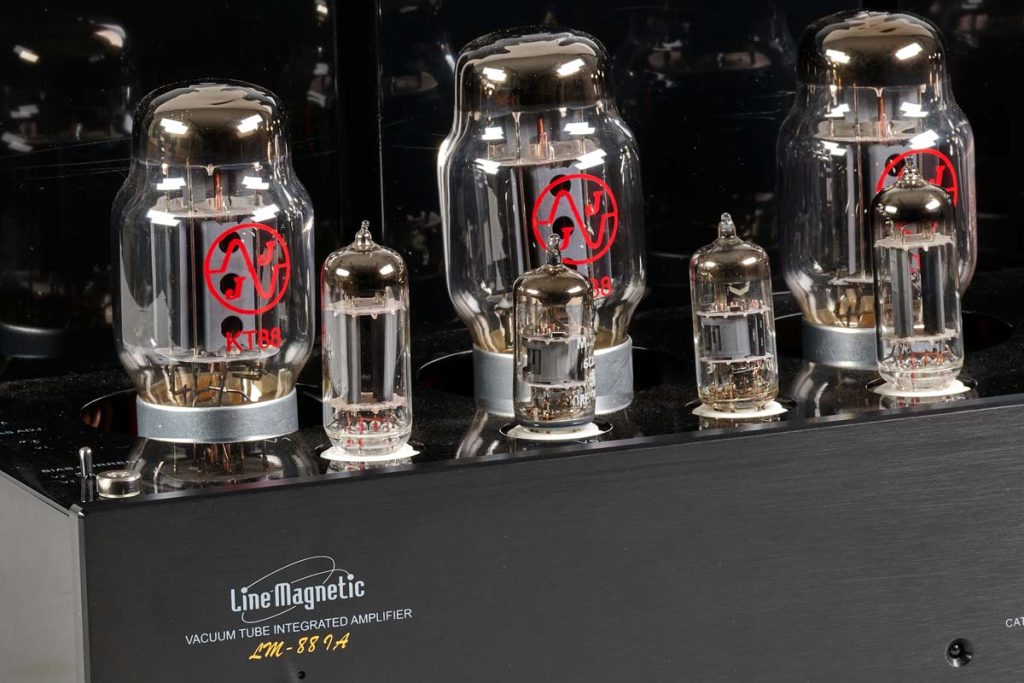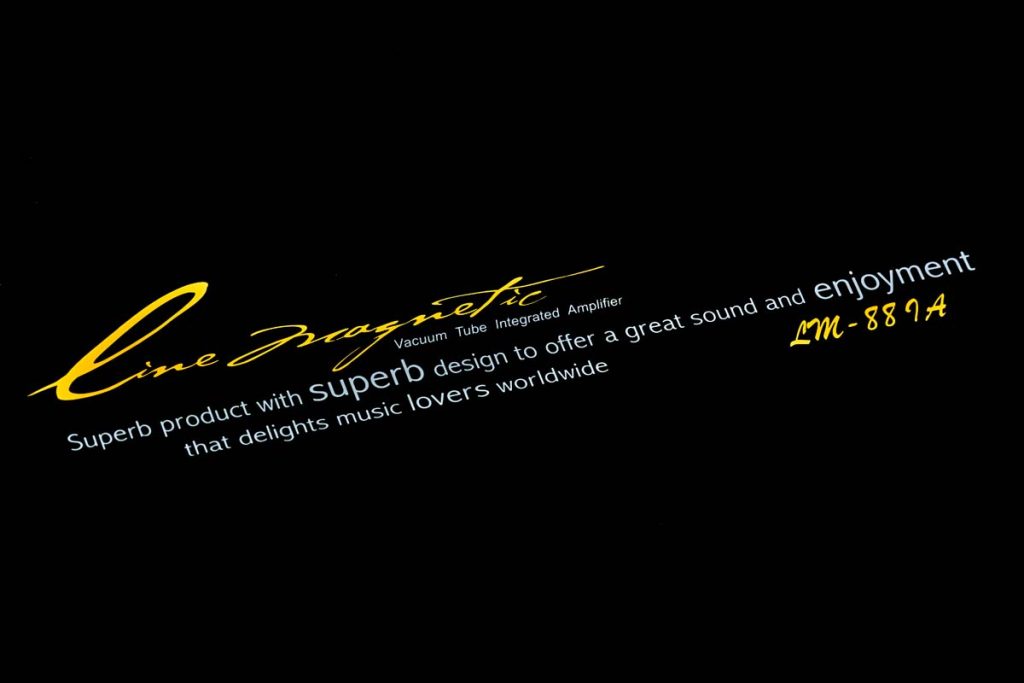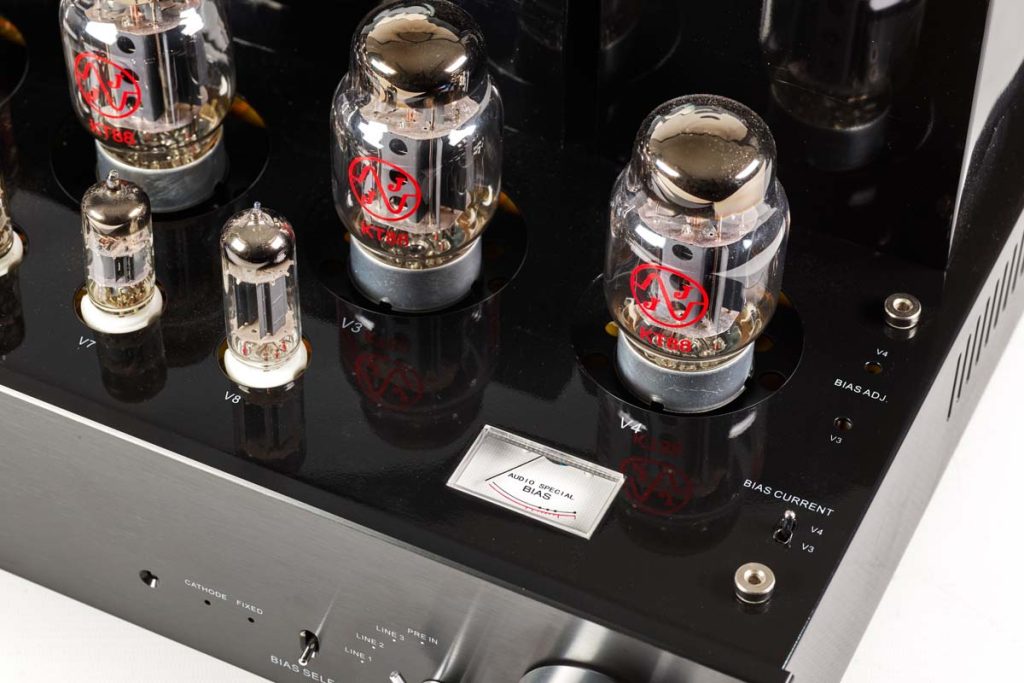Half a hundredweight and change of copper, glass and steel has taken its place on my rack.
It’s the Line Magnetic LM-88IA integrated amplifier. A classic push-pull tube amplifier with a powerful 42 watts of output power at the solid speaker terminals. Wired point-to-point, the signal is processed below the tubes by a Japanese EI output transformer for each channel. Lights off – tubes on!
All eight tubes are matched and selected at the factory. This applies to the Electro Harmonix 12BH7 and Mullard 6CL8A in the preamp as well as to the matched KT88 in the power amp, which come from JJ Electronics. The tubes can be operated either in fixed mode or in cathode mode, which is switched via a solid toggle switch on the front panel. In fixed mode, 2 x 42 watts are available at the speaker outputs, in cathode mode it’s 2 x 30 watts.
There are taps for speakers with 4, 8 or 16 ohms. There are also four unbalanced RCA inputs, three of which are regular high-level inputs, while the outer one is a power amplifier input so that the LM-88IA can also be integrated into a multi-channel setup. So far, so practical. However, there is no headphone output, preamp output or tape loop.
I connected my Klipsch Heresy IV with a nominal sensitivity of 99 decibels (1 W/1 m). With 24 bit and 96 kilohertz resolution, the new Daughter album Stereo Mind Game is delivered from the streaming world to my Luxman converter, whose analog output is connected to the Line Magnetic. And holy cow: Elena Tonra’s voice is placed larger than life between the speakers, while the percussive accents of the production are pushed into the listening room crisply and with pressure. It’s powerful, fast and convinces even in the next room with a confident, thoroughly voluminous performance. As I write these lines, I’m listening in the slightly warmer, rounder, but also more controlled sounding fixed mode. This is particularly noticeable at low volumes. Here, the LM-88IA already delivers a decent low-frequency foundation with a deep stage presentation. I particularly notice this with the spherical “Be On Your Way”, a track that sounds a little like a well-executed mixture of The XX and London Grammar. But the cathode bias with a somewhat more neutral, albeit dynamic, presentation will also appeal to many listeners: they have a choice between the two modes by simply flipping the aforementioned switch on the enclosure.
These days, the KT88 tube type used in the power amplifier is predominantly used in hi-fi amplifiers rather than guitar amps due to its tonal tendencies (clear and open), with exceptions proving the rule as always. Of course, the sound quality depends not only on the tubes used, but also on the circuitry and components of the respective amplifier. And the components in the LM-88IA are of the highest quality: volume potentiometers from ALPS in Japan, American MIT and German MCAP capacitors, to name but a few.
In fixed mode, the bias current, which is adjusted to the selected and installed JJ KT88s, is set comparatively high ex works, so that the Class AB amplifier remains in Class A mode up to quite a high output power level. If you are satisfied with the set of JJ tubes, you do not need to adjust the bias current yourself, the manufacturer has already done this. However, you can adjust the bias current of the LM-88IA in fixed mode for each power amp tube yourself (!) using a screwdriver and looking at the built-in ampere meter, should you ever want to replace the tubes or readjust them after a while – the keyword here is tuberolling. It is not necessary to adjust the bias current in the cathode bias (see box). However, at 30 watts, slightly less power is available at the speaker terminals. The fixed mode therefore encourages you to experiment and you can, for example, use alternative tube sets with octal sockets to the installed KT88 (e.g. KT100, KT150 or 6550), as the bias current can be adjusted accordingly. However, the set of JJ power amplifier tubes installed is already very decent and in the same price league as the competitors from BTB, Mullard (Russia) or TungSol (6550). The manufacturer itself lists alternative tube types for this amplifier in its documentation. The 12BH7 from the preamp section can also be replaced with a 12AU7EH. Depending on taste and budget.
With The Layers, jazz guitarist Julian Lage has released an atmospherically dense additional mini-album to last year’s View With A Room. The songs, recorded together with his fellow musicians Jorge Roeder (bass) and Dave King (drums), are also accompanied by Bill Frisell. The resulting recordings are musically rather calm and relaxed, but even so, they’ve been captured for posterity with a high dynamic range on the recordings. Especially on the tracks dominated by the acoustic guitar (“Double Southpaw”), the Line Magnetic creates a closeness to the musicians through its dynamic reproduction, even in fixed-bias mode! The steel strings enter the listening room with a sensitive yet fast attack, while Jorge Roeder’s double bass provides woody, clear support with sufficient body. The integrated amplifier manages the balancing act between detail resolution and musical cohesion. Despite the small line-up, the dynamics of the band make the music an experience for fans of cultivated guitar jazz. No easy listening platitudes, but great compositions that are reproduced with beautiful depth. The stage set up between the stereo speakers describes a rich, even semicircle to the rear. The front edge of the stage is exactly on the line between the speakers. This makes listening a relaxed affair, as the LM-88IA doesn’t sound shouty, but rather confident and always seems to be in control of the situation. Once again, I am referring primarily to the fixed bias mode. In cathode bias, the balance is maintained, but I personally find the low registers a little lacking in control. However, this can be dead right when it comes to current pop productions where the mastering tends to be somewhat overdone. The differences between the two modes are not huge, but they are audible. The basic character of the Line Magnetic remains the same in each case.
Presently, the current Gorillaz album Cracker Island is playing with the catchy mid-tempo number “Silent Running”. Damon Albarn caresses the ear canal with a catchy, slightly melancholy vocal melody. Timelessly beautiful and contemporary production. The drums here are straightforward, the keyboards with filtered sawtooth sounds sing in Mike-and-the-mechanics style, and the whistled melody floats on a tasteful, albeit very spacious, cloud of reverb. Even if this pop production is in no way comparable to Julian Lage’s excellently recorded jazz album, the LM-88IA is and remains an amplifier for long listening sessions. It takes out the slight “harshness” of the Gorillaz recording, but at the same time it shows the differences between the two recordings. The basic sound characteristics of each record remain unaffected. However, with some master tapes that are apparently optimized for mobile playback devices, the Line Magnetic removes the unpleasant frequency boosts by saturating them slightly. This reminds me of good analog devices in a mastering chain, which enhance the sound simply by passing the signal through without any filters being active. With good recordings, the Line Magnetic makes the stereo image a little fuller and warmer than would be the case with comparable semiconductor colleagues in this price range.
I also want to listen to some classical music. Rafał Blechacz plays Chopin. In his latest recording for Deutsche Grammophon, the Polish pianist shows why he has been one of the best Chopin interpreters for many years (his first Chopin recording in 2007 won the Echo Klassik award, among others). Chopin’s Piano Sonata in B minor op. 35 no. 2 is technically demanding, but in this recording it is vivid, dynamic and emotional. You can hear that Blechacz has had this sonata in his live repertoire for a long time. The Line Magnetic once again demonstrates its dynamic capabilities. This creates an intimate emotionality that is maintained even at low playback volumes. The instrument sounds just as natural and realistic in the quiet passages as it does in the forte. At the same time, the integrated tube amplifier always plays in the service of the music it is presented with and allows it its own characteristics. Just listen to the well-known funeral march: It has an unusual depth and allows this very frequently played piece to shine in a new light.
Thanks to its 42 watt output power, the LM-88IA can easily handle a variety of loudspeakers and always retains superior control, especially when it comes to the dynamics of the recordings. High-quality components and equally high-quality workmanship, two different tube modes and the option of manually calibrating alternative tubes round off the harmonious package.
FIXED AND CATHODE BIAS
The quiescent current (bias) is an important factor for a tube. If it is set too low, the amplifier will sound flat and powerless at best; if it is set too high, the tube can be damaged. With cathode or auto bias, a low-value resistor is installed between the cathode and earth and provides the necessary negative bias voltage. The optimum cathode resistor strikes a balance between the highest possible power output and the lowest possible distortion. Although a slightly higher cathode resistance extends the service life of the tube, it also reduces the power output. In general, a tube works less efficiently in cathode bias mode than in fixed mode and is more prone to slight distortion – but in theory it sounds more dynamic. When changing tubes, this type of circuit does not need to be recalibrated, hence the term “auto bias”.
In the “fixed bias” operating mode, the operating point of each tube is set with an adjustable resistor (potentiometer). The circuit is more efficient and delivers more output power with the same tube. It is also less prone to distortion, sounds more controlled and is generally slightly less dynamic than cathode bias circuits.
Accompanying Equipment
Integrated amplifier: Luxman SQ-N150 | Turntable: Elac Miracord 70 with AT-PTG33/II | Phono preamplifier: Luxman E-250 | CD player/converter: Luxman D-N150 | Speakers: Klipsch Heresy IV, Quad S4 | Cables: Ecosse, Tara Labs, HMS, Furutech, Supra
Integrated tube amplifier Line Magnetic LM-88IA
Concept: Integrated tube amplifier with negative feedback and selectable modes (cathode or fixed bias) | Special features: Ammeter for setting the bias current of the output tubes, point-to-point wiring, remote control, easy-to-understand operating instructions in German | Inputs: 3 x RCA (line), 1 x RCA (output stage) | Outputs: 1 pair of speaker binding posts with taps for 4, 8 and 16 Ω | Finish: black | Output per channel (4 Ω): 42 W (fixed bias), 30 W (cathode bias) | Dimensions (W/H/D): 44/22/37 cm | Weight: 30 kg | Warranty period: 2 years | Price: around €3300
IAD GmbH
Johann-Georg-Halske-Straße 11
41352 Korschenbroich
Phone +49 2161 617830
info@iad-gmbh.de
www.linemagnetic-deutschland.de

